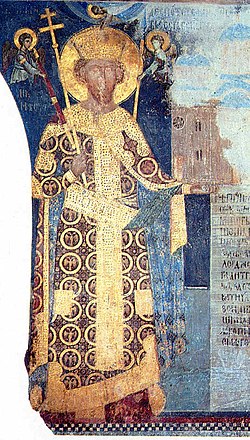Top Qs
Timeline
Chat
Perspective
July 19 (Eastern Orthodox liturgics)
From Wikipedia, the free encyclopedia
Remove ads
July 18 - Eastern Orthodox Church calendar - July 20

All fixed commemorations below are celebrated on August 1 by Old Calendar.[note 1]
For July 19th, Orthodox Churches on the Old Calendar commemorate the Saints listed on July 6.
Saints
- Venerable Abba Diocles of the Thebaid (4th century)[1][2][3]
- Venerable Macrina the Younger, sister of Saints Basil the Great and Gregory of Nyssa (380)[1][3][4][5][6][note 2]
- Venerable Dius of Antioch, Abbot, Wonderworker (c. 430)[1][3][8][9][10][11]
- The Venerable 4 (or 40) fellow ascetics.[10][12][13]
- Saint Gregory of Panedus, Bishop of Panedus, New Confessor for the holy icons’ sake.[3][10][13][14][note 3]
- Venerable Theodore the Sabbaite, Archbishop of Edessa in Mesopotamia (848)[1][3][10][13][15] (see also: July 9)
- Venerable Michael, ascetic at the Holy Lavra of Saint Sabbas and the nephew of Venerable Theodore the Sabbaite the Bishop of Edessa.[3][13][16]
Remove ads
Pre-Schism Western saints
- Saint Martin of Trier, tenth Bishop of Trier in Germany and possibly a martyr (c. 210)[17][note 4]
- Saints Justa and Rufina of Seville, two sisters, potters by trade, martyred under Diocletian and venerated as the main patron-saints of Seville (287)[10][17][note 5]
- Saint Arsenius the Great of Scetis, an anchorite in Egypt and one of the most highly regarded Desert Fathers (c. 449)[17][18][note 6][note 7] (see also: May 8)
- Saint Felix of Verona (Felicinus, Felice), Bishop of Verona in Italy, venerated from ancient times as a saint.[7][17]
- Saint Symmachus, Pope of Rome (514)[17][19][note 8][note 9]
- Saint Ambrose Autpertus, a Frankish Benedictine abbot (c. 778)[17][note 10]
- Saint Jerome of Pavia, Bishop of Pavia in Italy (787)[17]
- Saint Aurea of Córdoba (Aura), a nun at Santa María de Cuteclara de Córdoba, martyred by beheading (856)[10][17][note 11][note 12]
Remove ads
Post-Schism Orthodox saints
- Blessed Romanus of Ryazan, Prince of Ryazan (1270)[1][10][20][21][note 13]
- Venerable Paisius of Kiev Far Caves (14th century)[1][10][13][21][22]
- Blessed King Stefan Lazarević of Serbia (1427), and his mother St. Milica of Serbia (Eugenia in schema) (1405)[1][10][21][23][24]
- Saint Sophronius (Smirnov), Archimandrite, of Svyatogorsk Monastery (1921)[1][note 14]
Other commemorations
- Icon of the Most Holy Theotokos "Umileniye" ("of Tender Feeling") of Diveyevo Convent (1885)[25] (see also: July 28)
- Uncovering of the relics (1903) of Venerable Seraphim of Sarov, Wonderworker (1833)[1][10][13][21][26]
- Commemoration of the miracle (1944) of Hieromartyr Charalampus (202), who saved the residents of Erana-Filiatra in Messinia from certain death.[27]
- Synaxis of the Saints of Kursk.[1][21][28]
- Repose of Hiero-Schemamonk Anthony of Valaam (1862)[1]
- Repose of Blessed Abbot Nilus, of St. Nilus of Sora Monastery (1870)[1][note 15]
- Repose of Elder John, of St. Nilus of Sora Monastery (1903)[1]
- Repose of Archimandrite Nektary (Chernobyl) of Jerusalem (2000)[1]
Remove ads
Icon gallery
- Venerable Macrina the Younger.
- Sts. Justa and Rufina of Seville.
- St. Arsenius the Great of Scetis.
- St. Symmachus, Pope of Rome.
- St. Roman of Ryazan.
- Blessed King Stefan Lazarević of Serbia.
- St. Milica of Serbia (Eugenia in schema).
- Venerable Seraphim of Sarov.
- Hieromartyr Charalampus, Bishop of Magnesia in Asia Minor.
Notes
- The notation Old Style or (OS) is sometimes used to indicate a date in the Julian Calendar (which is used by churches on the "Old Calendar").
The notation New Style or (NS), indicates a date in the Revised Julian calendar (which is used by churches on the "New Calendar"). - "In Cappadocia, the holy virgin Marcina, sister of St. Basil the Great and St. Gregory of Nyssa."[7]
- He is recorded in the Patmos Codex 266, without biographical details. However the "Diocese of Panedus" is not found anywhere; it was probably a reference to "Panios", which was located at Herakleia in Thrace.
- "At Seville, in Spain, the martyrdom of the holy virgins Justa and Rufina. Arrested by the governor Diogenian, they were stretched on the rack and lacerated with iron claws, then imprisoned, and subjected to starvation and various tortures. Lastly Justa breathed her last in prison, and Rufina had her neck broken while confessing Christ."[7]
- Surnamed also 'the Roman' and 'the deacon', being actually a Roman deacon. He was called by Theodosius the Great to Constantinople to become the tutor of Arcadius and Honorius, the Emperor's sons (c 383). After ten years in that office (c 393) he abandoned the court and retired to the desert of Skete as a hermit. He remained a hermit for the rest of his life, living in various places in Egypt, always weeping over the feebleness of Arcadius and the foolishness of Honorius. He reposed at the rock of Tröe near Memphis.
- Born in Sardinia, he became Pope of Rome in 498. Energetic and competent, despite the activities and accusations of enemies, he built many churches in Rome.
- Born in France, he went to Italy as an envoy and visited the monastery of St Vincent near Benevento, where he became a monk. Eventually he became abbot.
- See: (in Russian) Роман Ольгович. Википедии. (Russian Wikipedia).
- See: (in Russian) Софроний (Смирнов). Википедии. (Russian Wikipedia).
- See: (in Russian) Нило-Сорская пустынь. Википедии. (Russian Wikipedia).
Remove ads
References
Sources
Wikiwand - on
Seamless Wikipedia browsing. On steroids.
Remove ads









